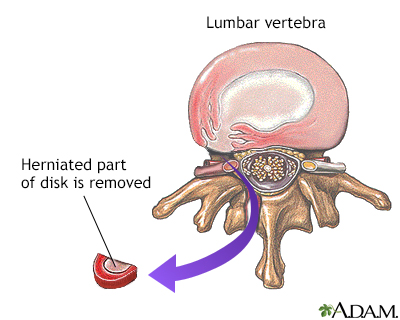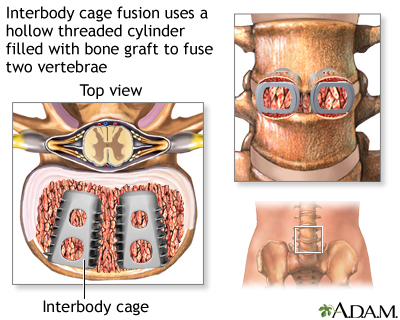| When is surgery necessary? |
Surgery may be considered if you have back pain from a herniated disk, spinal stenosis, or sciatica that does not respond to medication or physical therapy. Even though surgery is an option for these conditions, treating them without surgery is better whenever possible. In fact, 90% of people with a herniated disk can be treated without surgery.
Laminectomy and laminotomy
Operations that remove all (laminectomy) or part (laminotomy) of the arch of the vertebrae may be used if you have spinal stenosis or some other vertebral abnormality pressing on a nerve. This surgery may also be considered as part of a larger procedure to remove a tumor on the spine. Like diskectomy, many people will feel immediate relief after the procedure. However, recurrent back pain is very common.

Diskectomy
This surgical procedure removes the disk that is causing your pain. By doing this, pressure on your spine is relieved. There are now ways to perform this surgery with as little invasion as possible. For example, very small incisions may be used.

| In a diskectomy, part or all of the disk is removed, which reduces pressure on the spinal nerve. |
While there may be an immediate relief from pain following this operation, it is not clear whether this provides any more long-term improvement than treatment with medications, physical therapy, exercise, and the other measures discussed in this guide.
Following the procedure, you may develop scar tissue, which could cause back pain itself. You will need to do a lot of resting for 3 - 4 days after this surgery. But, it may take 4 - 6 weeks to fully recover.
Spinal fusion
When motion between two or more vertebrae causes severe pain, your surgeon may recommend spinal fusion. Spinal fusion may also be done, if you have surgery to remove a disk or some bone, to prevent motion from occurring between two vertebrae.
This procedure eliminates motion between the bones of the back by eliminating the joints between the bones and forming a solid bony bridge. This is usually done by using a combination of metal implants, like screws and rods, and grafting bone onto the spine from another part of your body. The bone often comes from your pelvis.
Recovery from this procedure usually takes longer than from diskectomy or laminectomy. Your surgeon may recommend you wear a brace after surgery as the bone heals. This type of surgery is usually for people with chronic back pain that has not responded to other treatments. Spinal fusion may also help people who have instability of the spine, a condition that occurs when the connections between the vertebrae have deteriorated. The procedure allows vertebrae to slide back and forth against each other.

Disk replacement
The artificial disk is a newer method of spine surgery. This implanted device is an alternative to fusion for some people.
Sometimes, a degenerated disk that is causing back pain needs to be removed through surgery. However, when a disk is removed, the vertebrae in that area of the spinal column must be re-connected. Typically, surgeons will use spinal fusion to reconnect the vertebrae, which eliminates motion between the vertebrae. The artificial disk, however, preserves motion between the vertebrae.
While experts believe there are many advantages to preserving motion, no long-term studies prove that replacing a disk with an artificial one is better than spinal fusion. Some surgeons are waiting for the results of more research, particularly longer-term follow-up of more patients to make sure there are no serious complications, before recommending this new technology.
Reviewed By: Andrew W. Piasecki, MD, Camden Bone and Joint, LLC, Orthopaedic Surgery/Sports Medicine, Camden, SC. Review provided by VeriMed Healthcare Network. Also reviewed by David Zieve, MD, MHA, Medical Director, A.D.A.M., Inc.
